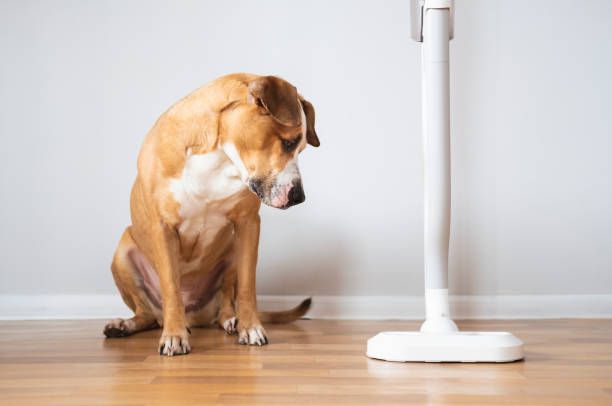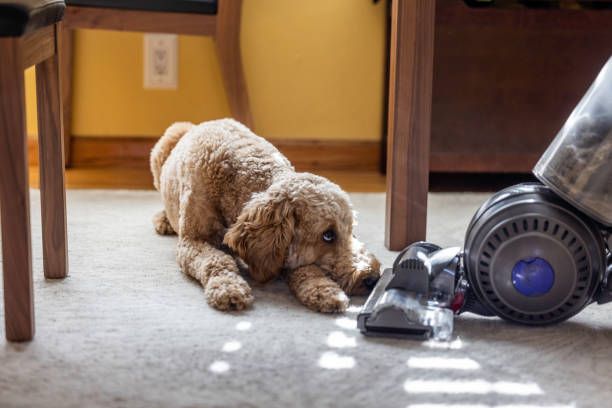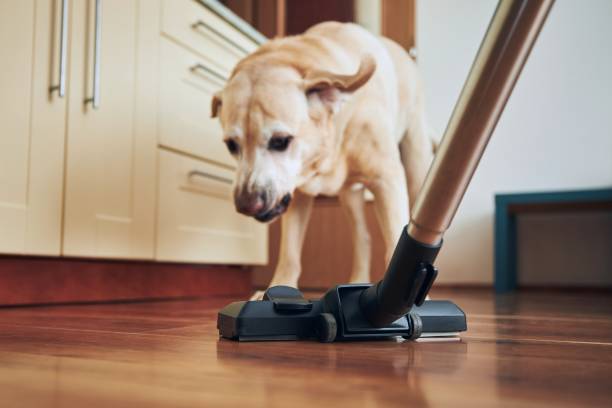Dogs are our loyal companions, offering us unwavering love and companionship. But there's one thing that often sends them into a frenzy of anxiety - the dreaded vacuum cleaner. If you've ever wondered why your furry friend cowers, barks, or even attacks the vacuum, you're not alone. In this article, we'll delve into the fascinating world of canine psychology to understand why dogs dislike vacuums and how you can help them cope with their anxiety.

The Vacuum Monster: A Dog's Perspective
Imagine you're lounging peacefully on the couch, enjoying a snooze or gnawing on your favorite toy when suddenly, a roaring, monstrous contraption comes to life. It's loud, it moves unpredictably, and it swallows everything in its path. For dogs, that's exactly how a vacuum cleaner appears. From their perspective, it's a menacing intruder invading their territory.
Dogs have keen senses, especially their hearing and sense of smell. Vacuum cleaners emit a high-pitched noise that's not only loud but also irritating to their sensitive ears. The vacuum's motor and the sound of debris being sucked up create a cacophony that's hard for them to bear. This sensory overload can trigger a flight or fight response, leading to anxiety and stress.
Evolutionary Roots of Anxiety
To truly understand why dogs dislike vacuums, we need to look back in time. Dogs are descendants of wolves, and their instincts are deeply rooted in their evolutionary history. In the wild, sudden, loud noises often meant danger - a potential predator or threat lurking nearby.
When a vacuum cleaner roars to life, it taps into this primal instinct. Your dog's brain goes on high alert, trying to decipher whether this new "predator" poses a threat. Their natural response is to either flee from the perceived danger or confront it head-on, barking and growling.
Noise Sensitivity in Dogs
Not all dogs react the same way to vacuums, and that's because noise sensitivity varies from one dog to another. Some dogs may barely flinch, while others might tremble with fear. This variation can be attributed to a combination of genetics and individual experiences.
Certain dog breeds are more predisposed to noise sensitivity. Breeds like Border Collies, German Shepherds, and Terriers are known to be more alert and reactive to sounds. However, individual experiences also play a significant role. A dog that had a traumatic experience with a vacuum as a puppy is more likely to develop a strong aversion to it.
Canine Anxiety: The Vacuum Connection
So, why do dogs dislike vacuums? The answer largely lies in the realm of canine anxiety. Just like humans, dogs can experience anxiety and stress triggered by various factors, including loud noises, unfamiliar objects, and changes in their environment.
When a dog encounters a vacuum cleaner, it checks several anxiety-inducing boxes:
- Loud Noise: The vacuum's deafening noise can send their stress levels soaring.
- Unpredictable Movement: The vacuum moves erratically, making it difficult for dogs to predict its path.
- Intrusion of Territory: Dogs are territorial animals, and the vacuum invading their space can feel threatening.
The combination of these factors can lead to heightened anxiety and fear, resulting in the behaviors you witness when you turn on the vacuum.
Signs of Vacuum Anxiety in Dogs
Understanding your dog's anxiety is crucial to help them overcome it. Dogs display a range of behaviors when confronted with the vacuum monster. Here are some common signs of vacuum anxiety:
1. Barking and Growling
When a dog perceives the vacuum as a threat, barking and growling are their way of warning it to stay away.
2. Hiding or Fleeing
Some dogs prefer to retreat and hide in a safe place when the vacuum is in action. This is their way of seeking refuge from the perceived danger.
3. Chasing or Attacking
In some cases, dogs may go on the offensive and try to chase or attack the vacuum. This behavior stems from their instinct to protect their pack (you) from threats.
4. Trembling and Shaking
The stress and anxiety caused by the vacuum can lead to physical symptoms like trembling and shaking.
5. Excessive Salivation
Anxious dogs may drool excessively as a response to stress.
Understanding these signs is the first step in helping your furry friend overcome their vacuum-induced anxiety.
How to Help Your Dog Cope
Now that we've decoded why dogs dislike vacuums and the anxiety it triggers, let's explore ways to make this situation less stressful for your pet.
1. Gradual Desensitization
Start by desensitizing your dog to the vacuum gradually. Begin by placing the vacuum in the room without turning it on. Let your dog investigate it at their own pace. Reward them with treats and praise for calm behavior.
2. Positive Associations
Associate the vacuum with positive experiences. Before turning it on, give your dog their favorite treat or toy. This helps them form a positive connection with the vacuum.
3. Training and Distraction
Teach your dog basic obedience commands like "sit" and "stay." Use these commands to keep them in a designated area while you vacuum. Provide them with toys or treats to keep them distracted.
4. White Noise or Music
Play calming white noise or soothing music to drown out the vacuum's noise. This can help reduce their anxiety.
5. Professional Help
If your dog's anxiety is severe and affecting their quality of life, consider seeking help from a professional dog trainer or behaviorist.

Beyond Vacuum Anxiety: A Broader Look at Canine Emotions
Understanding why dogs dislike vacuums and the anxiety it provokes also provides a glimpse into the intricate world of canine emotions. Dogs are not just simple creatures; they possess a wide range of emotions, just like humans. By delving deeper into this topic, we can decode more about our furry friends' feelings and behaviors.
1. Fear and Anxiety
As we've explored, dogs can experience fear and anxiety, often triggered by various stimuli. Whether it's thunderstorms, fireworks, or vacuum cleaners, recognizing these emotions is essential for providing them with the support and comfort they need.
2. Joy and Excitement
On the flip side, dogs are masters at exuding joy and excitement. The tail wagging, the bounding leaps, and the happy barks - these are all expressions of their exuberant emotions. Understanding what makes your dog happy is just as crucial as addressing their fears.
3. Love and Attachment
Dogs are known for their unwavering love and loyalty. The bond they share with their human companions is built on a foundation of trust, love, and attachment. Recognizing and reciprocating this affection is vital for maintaining a strong and healthy relationship.
4. Stress and Discomfort
Apart from vacuum-induced stress, dogs can experience stress in various situations. Changes in routine, new environments, or interactions with unfamiliar dogs or people can all trigger stress. Identifying these stressors can help you create a more stress-free environment for your pet.
5. Loneliness and Boredom
Dogs are social animals that thrive on companionship and mental stimulation. Loneliness and boredom can lead to destructive behaviors. Providing them with social interaction, toys, and mental challenges can combat these feelings.
6. Grief and Loss
Dogs can also experience grief and loss when they lose a fellow pet or a human family member. Recognizing their grief and offering comfort can help them cope during these difficult times.
The Complexity of Canine Communication
Dogs communicate with us in various ways, using their body language, vocalizations, and behaviors. Understanding these signals is essential for fostering a strong bond and ensuring their well-being.
Body Language
Pay attention to your dog's body language. A wagging tail can indicate happiness, while a tucked tail suggests fear or submission. Raised hackles may signify agitation. Learning to interpret these cues helps you respond appropriately to your dog's emotional state.
Vocalizations
Dogs communicate through barks, whines, and growls. Each vocalization has its own meaning. For instance, a playful bark is different from a fearful growl. By recognizing these vocal cues, you can better understand what your dog is trying to convey.
Behavioral Changes
Sudden changes in behavior can be a sign that something is amiss. If your normally energetic dog becomes lethargic or if they start avoiding certain situations, it could indicate underlying issues that require attention.
The Power of Empathy
In the quest to decode your dog's emotions, empathy plays a vital role. Empathy means putting yourself in your dog's paws, understanding their perspective, and responding to their needs with care and compassion.
Empathy helps you make informed decisions regarding their training, socialization, and healthcare. It allows you to create a safe and nurturing environment where your dog can thrive emotionally and physically.

Beyond Companionship: The Therapeutic Benefits of Dogs
While understanding why dogs dislike vacuums and decoding their emotions is crucial, it's also worth exploring the broader impact these four-legged friends have on our lives. Dogs bring much more to the table than just being adorable companions. They possess a unique set of qualities that can enhance our physical and mental well-being.
1. Stress Reduction
Numerous studies have shown that interacting with dogs can significantly reduce stress levels. The simple act of petting a dog releases feel-good hormones like oxytocin and lowers the stress hormone cortisol. It's no wonder dogs are often used in therapy settings to help people cope with anxiety and stress.
2. Physical Health Benefits
Dogs encourage physical activity. Regular walks, hikes, and playtime with your pup contribute to a healthier lifestyle. Additionally, dog owners tend to have lower blood pressure and reduced risk of heart disease.
3. Emotional Support
Dogs provide unwavering emotional support. They are there to lend a listening ear (or a furry shoulder to cry on) when you're feeling down. Their unconditional love and non-judgmental nature can make tough days more manageable.
4. Social Connection
Dogs are social magnets. They provide opportunities for social interaction with other dog owners, creating a sense of community and reducing feelings of loneliness and isolation.
5. Improved Mental Health
The presence of a dog can help alleviate symptoms of depression and anxiety. Their playful antics and affectionate gestures can boost your mood and overall mental well-being.
6. Enhanced Quality of Life
Dogs can add purpose and structure to your daily routine. Their needs, such as feeding, exercise, and grooming, can help provide a sense of responsibility and fulfillment.
7. Therapeutic Roles
Dogs are employed in various therapeutic roles. They serve as therapy dogs in hospitals, nursing homes, and schools, providing comfort and companionship to those in need. Service dogs assist individuals with disabilities, offering invaluable assistance and support.
A Unique Connection
The bond between humans and dogs is a testament to the power of interspecies relationships. It transcends language and cultural barriers, offering a connection that is both primal and profound.
This unique connection has led to the co-evolution of humans and dogs over thousands of years. Our ancestors likely first formed bonds with wolves, which eventually led to the domestication of dogs. In return for our companionship and protection, dogs became invaluable partners in hunting, herding, and guarding.
Today, while dogs may no longer play the same roles they once did, their impact on our lives remains undeniable. They have evolved to adapt to our changing needs, serving as loyal friends, family members, and even essential workers.
The Responsibility of Dog Ownership
As we bask in the joys of canine companionship and reap the therapeutic benefits they offer, it's essential to remember the responsibilities that come with dog ownership. Providing proper care, love, and a safe environment should be the priority of every dog owner.
Here are some essential responsibilities:
1. Health Care
Regular veterinary check-ups, vaccinations, and preventive care are vital to ensure your dog's well-being.
2. Nutrition
Providing a balanced diet that meets your dog's nutritional needs is crucial. Consult with your vet to choose the right food for your pup.
3. Exercise and Mental Stimulation
Dogs need both physical activity and mental stimulation to thrive. Regular exercise and interactive playtime are essential.

4. Training and Socialization
Proper training and socialization ensure that your dog is well-behaved and comfortable in various situations.
5. Love and Attention
Dogs thrive on love and attention. Spend quality time with your pet, offer affection, and build a strong bond.
6. Safety
Keep your dog safe by providing a secure environment, using appropriate restraints, and ensuring they are protected from hazards.
Conclusion:
In conclusion, understanding why dogs dislike vacuums is just one facet of the intricate world of canine emotions. Dogs, our steadfast companions, offer us not only love but also therapeutic benefits, reducing stress, enhancing our physical and mental health, and providing emotional support. This unique connection between humans and dogs transcends time and culture. However, it comes with significant responsibilities, from proper care and training to ensuring their safety and well-being. As we navigate the complexities of our relationships with these loyal friends, let's remember to cherish their unwavering love, empathy, and the profound connection that enriches our lives in countless ways.
FAQs
- Why do dogs dislike vacuums so much?
- Dogs often dislike vacuums due to the loud noise they produce, which can be startling and distressing to their sensitive ears. The vacuum's unpredictable movement and intrusion into their territory can trigger fear and anxiety, leading to their aversion.
- Are certain dog breeds more prone to vacuum anxiety?
- Yes, some dog breeds are more predisposed to noise sensitivity and anxiety. Breeds like Border Collies, German Shepherds, and Terriers are known to be more alert and reactive to loud sounds. However, individual experiences also play a significant role in a dog's anxiety level.
- How can I help my dog cope with vacuum anxiety?
- You can help your dog cope with vacuum anxiety through gradual desensitization, positive associations, training and distraction, using white noise or music to mask the vacuum's sound, and seeking professional help if their anxiety is severe.
- What are the signs of vacuum anxiety in dogs?
- Signs of vacuum anxiety in dogs include barking, growling, hiding or fleeing, chasing or attacking the vacuum, trembling and shaking, and excessive salivation. These behaviors are typically triggered by the vacuum cleaner's presence or operation.
- Are there other situations that can trigger anxiety in dogs?
- Yes, dogs can experience anxiety in various situations, including thunderstorms, fireworks, changes in routine or environment, and interactions with unfamiliar dogs or people. Identifying these stressors is essential for managing their anxiety effectively.
- What are the therapeutic benefits of having a dog as a pet?
- Having a dog as a pet offers numerous therapeutic benefits, including stress reduction, improved physical health, emotional support, enhanced mental health, social connection, a sense of purpose, and opportunities for therapy and service work. Dogs can significantly enhance their owner's overall well-being.




